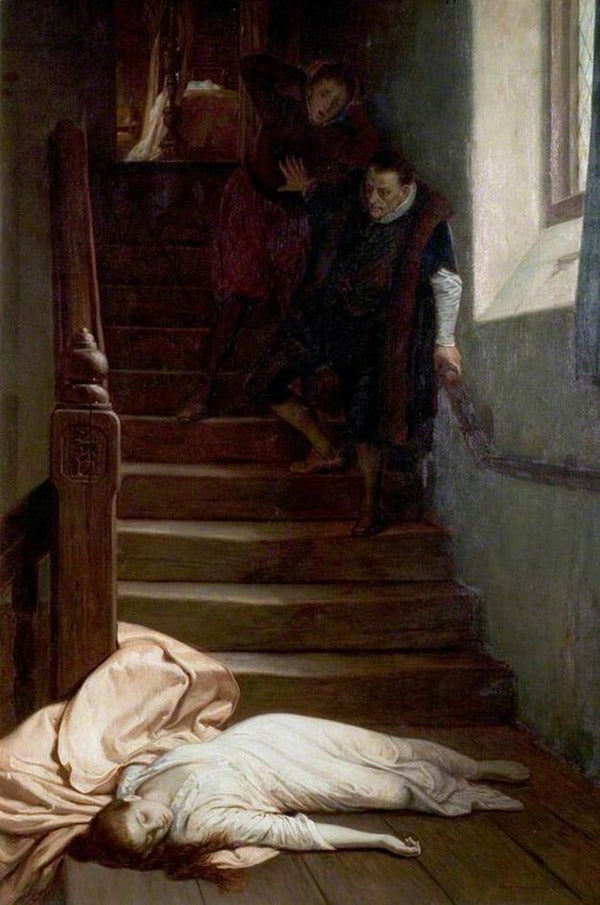Controversy is nothing new for the British royal family. Take, for instance, the scandal that grew from the events at Cumnor Place, a manor house on the grounds of the former Abingdon Abbey, Berkshire, in the sixteenth century.
Cumnor was leased by Sir Anthony Forster, the controller of Robert Dudley, 1st Earl of Leicester. Dudley’s twenty-eight-year old wife, Amy Robsart, resided there whenever he was away at the court of Queen Elizabeth I, his rumored lover. On September 8, 1560, with Dudley once again out of town with the queen, Robsart sent the entire household staff to Abingdon Fair for the day. When they returned, they found her dead at the bottom of the stairs. Could she have been murdered in the absence of witnesses? Did she commit suicide? Or was her death simply a tragic accident, the result of a stumble or misstep?
In 1956, Scottish surgeon Ian Aird considered the possible causes of Robsart’s death. According to his research, talk had almost immediately spread about what might have happened at Cumnor, with many opinions leaning toward a murder planned by Dudley. The evidence: Dudley had sent a letter “which anticipated malicious talk” to one of his household officers, Sir Thomas Blount. But Dudley also ordered Blount to make sure “that a coroner and juries should ‘search honorablie and duelie, by all manner of examynacions, the bottom of the matter.’”

Dudley failed to attend Robsart’s funeral, during which one of his own chaplains, Dr. Francis Babington, claimed she had been “pitfully slain” (the chaplain later said he had “tripped in his speech”). But one of the most telling accusations against Dudley wasn’t that he failed to attend the funeral, but a rumor spread by the Spanish ambassador to the English court, de Quadra. De Quadra reported that Dudley had said as early as March 1560 that he would be in a “new position” in a year. If indeed his wife died and he married the Queen of England, that would put him in a “new position.” De Quadra also gossiped about Robsart being poisoned.
Years later, Robsart’s brother accused Dudley of covering up his sister’s murder. But Dudley had his supporters, and Aird writes that his “contemporaries absolved him from blame,” accepting that Robsart’s death was accidental.
Whatever did happen at the staircase, Aird notes that suicide was likely not the cause of death:
The manner of Amy’s death almost certainly excludes suicide. To dive head foremost from an upper window or from a balcony has been used, though rarely, as a method of suicide. To project oneself down a flight of stairs would not occur to a suicide now, and would have occurred even less to an Elizabethan suicide at a time when the steps of staircases were broad and low, and the angle of descent gradual.
A coroner’s report from September 1561, a year after the death, also determined that Robsart wasn’t murdered. As Aird explains, a staircase isn’t a convenient weapon for murder. Even so, he didn’t find the verdict of misadventure convincing.
“The finding of Amy’s body at the bottom of the stairs with no other injury than a broken neck was one of the causes of contemporary suspicion,” he writes, and it made him suspicious, too. “Adults do not commonly fall downstairs and sustain a broken neck.” (Nota bene the more recent case of Kathleen Peterson’s death.)
In all likelihood, Aird concludes, a contributing factor to the fatal fall was a preexisting weakness. “The death of Amy Robsart can best be explained by the assumption that she died from a ‘spontaneous fracture’ of the spine, of a kind which might be expected from disease,” he writes.
Weekly Newsletter
Was Robsart weak from poison? Perhaps, or maybe she was suffering from cancer. Aird shares that a previous ambassador from the Spanish court had written that Robsart had “a malady in one of her breasts, and the queen [was] only waiting her death to marry Lord Robert.”
Whether or not Dudley had a role in it, the rumors following Robsart’s death brought his ambitions to a halt: he couldn’t marry Elizabeth I while standing in a swirling cloud of accusations.
Support JSTOR Daily! Join our new membership program on Patreon today.







